 
Energy Secretary Jennifer Granholm will provide an in-person keynote address at this year’s National Cleanup Workshop set for Sept. 11-13 at the Crystal Gateway Marriott in Arlington, Virginia, the event’s organizers announced last week.
Granholm joins a growing list of federal representatives, industry officials and state and local leaders speaking at this year’s workshop, one of the largest events in the country dealing with EM. Other speakers include:
- William “Ike” White, EM senior advisor;
- Jeff Avery, EM principal deputy assistant secretary;
- Dae Chung, EM associate principal deputy assistant secretary for corporate services;
- Greg Gervais, director, Federal Facilities Restoration and Reuse Office, U.S. Environmental Protection Agency;
- Brent Gerry, mayor, City of West Richland, Washington; and chair, Energy Communities Alliance (ECA); and
- Rebecca Casper, mayor, City of Idaho Falls, Idaho; and vice-chair, ECA.
 |
|
Energy Secretary Jennifer Granholm will address the 2023 National Cleanup Workshop. |
This year’s workshop also includes a new emphasis on early career professionals in the EM industry, with programming to learn more about EM and how to grow and succeed in the DOE cleanup program. These sessions will include:
- Leadership development principles;
- Case studies from federal and contractor representatives on building a career in the EM program; and
- An in-depth “EM 101” on the background and history of the DOE cleanup program.
Check out this EM webpage to find coverage of past workshops, including a video of White’s 2022 workshop keynote address. The site features EM Update newsletter reporting and a gallery of photos showcasing everything from the reception kicking off the event to a variety of speakers and panels.
Last year, about 630 in-person and 91 virtual participants attended the workshop, billed as the premier annual gathering to discuss progress in environmental cleanup of former government weapons sites and nuclear research facilities. ECA, with the cooperation of EM and the Energy Facility Contractors Group, host the workshop. Registration is open for this year's workshop.
 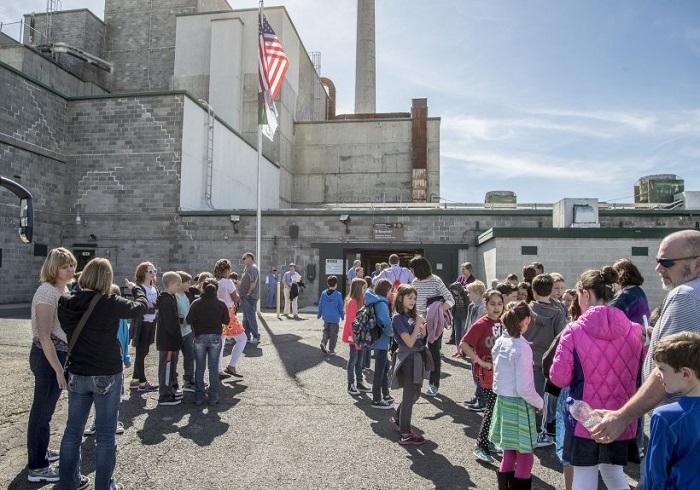 Students arrive at B Reactor at the Hanford Site in Washington state for a tour. DOE works with elementary, middle and high schools around the region to highlight B Reactor’s role in ushering in the atomic age, and the importance of STEM education.
Editor's Note
EM Update is highlighting the following piece featured on EM’s website as the new biopic on J. Robert Oppenheimer is set to hit theaters. This EM story — which is not an endorsement of the film — focuses on the Manhattan Project, the origin of EM’s nuclear cleanup mission. America’s greatest scientific and engineering minds, craft workers and military members worked side by side at several secret sites including Los Alamos, New Mexico, Richland, Washington, and Oak Ridge, Tennessee.
On July 16, 1945, the research and development efforts of the nation’s once-secret Manhattan Project were realized with the detonation of the world’s first nuclear device at the code-named “Trinity” test site over 200 miles south of Los Alamos, New Mexico.
This first-ever detonation of a nuclear device thrust mankind into a new era marked by the development of weapons with previously unimaginable power, and a complicated legacy that includes the fields of nuclear medicine and nuclear energy, the growth of a vital national laboratory system, and the vast environmental cleanup responsibilities entrusted to EM.
Today, EM continues cleanup activities from the impacts of national security efforts in World War II across the remaining Manhattan Project sites and those involved in the Cold War. EM’s charge also includes support for the preservation and recognition of some of the historic facilities of the Manhattan Project.
The B Reactor at the Hanford Site in Washington state was constructed in 1943 and produced plutonium used in the Trinity Test, as well as for the atomic bomb dropped on Nagasaki, Japan. Now one of five Hanford facilities in the Manhattan Project National Historical Park, B Reactor, has had visitors from all 50 states and more than 90 countries worldwide.
Los Alamos National Laboratory (LANL) was established for a single purpose: to design and build an atomic bomb. The EM Los Alamos Field Office, established in 2015, pursues an active legacy cleanup mission. It investigates hazardous chemical and radioactive materials contamination as a result of past LANL operations and remediates sites where such materials are found above acceptable regulatory levels.
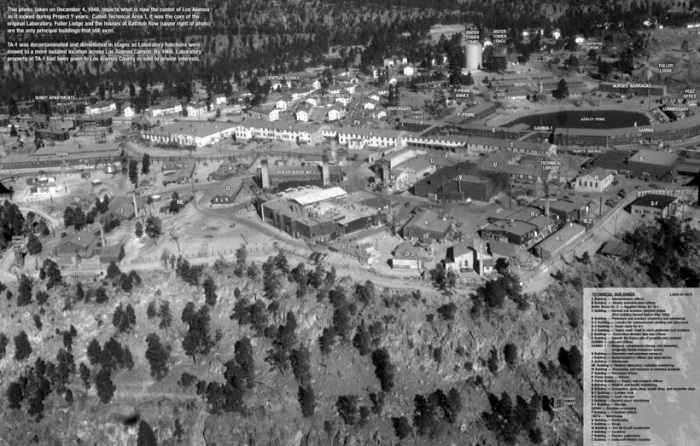 Los Alamos National Laboratory
 K-25 Building Site, now known as the East Tennessee Technology Park
The Graphite Reactor at Oak Ridge once produced the world’s first few grams of plutonium, created the first sparks of nuclear-generated electricity and went on to serve as one of the most prestigious nuclear research facilities in the world. Today, the Graphite Reactor serves as one of the Manhattan Project National Historical Park’s most popular attractions in Oak Ridge.
The K-25 building produced uranium for the world’s first nuclear weapons. The K-25 site, now known as the East Tennessee Technology Park, has been transformed by the EM program. More than 500 facilities have been demolished and much of the land has been transferred to the community for economic development, conservation and historic preservation including the K-25 History Center that opened in 2020.
 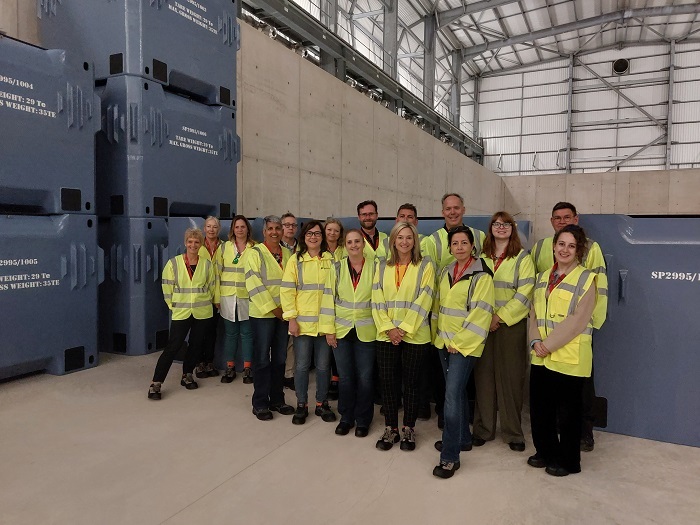 The delegations from the United States, United Kingdom and Canada are pictured inside the U.K. Nuclear Decommissioning Authority Sellafield Interim Storage Facility, which is vital to the U.K. waste retrieval mission.
LONDON – A team of leaders from EM headquarters and cleanup sites traveled to London, United Kingdom, to participate in a workshop with U.K. and Canadian government representatives and impacted stakeholders from July 11-14. The workshop focused on stakeholder engagement, which is critical to the cleanup of nuclear legacy sites.
“The completion of our milestones is not possible without strong stakeholder engagement throughout the cleanup process,” said Kristen Ellis, EM director of regulatory, intergovernmental and stakeholder engagement. “Our success in completing the technical aspects of a cleanup is directly related to engagement with our partners, elected officials and communities.”
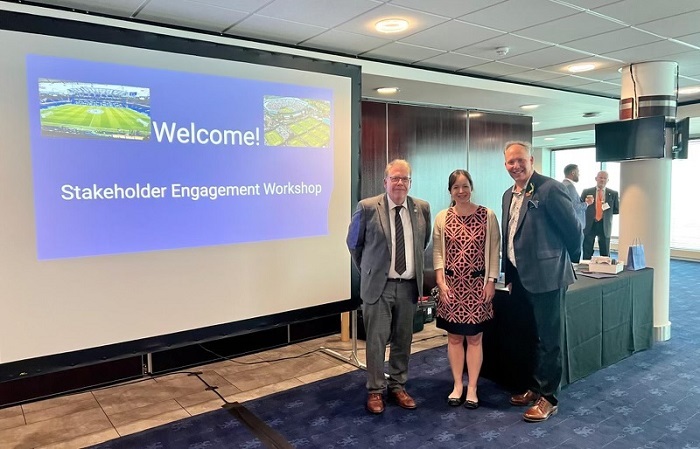 Pictured from left are John McNamara, head of stakeholder relations for the United Kingdom’s Nuclear Decommissioning Authority; Kristen Ellis, EM director of regulatory, intergovernmental and stakeholder engagement; and Jason Cameron, vice-president, communications and public affairs for Canada’s Atomic Energy of Canada Limited.
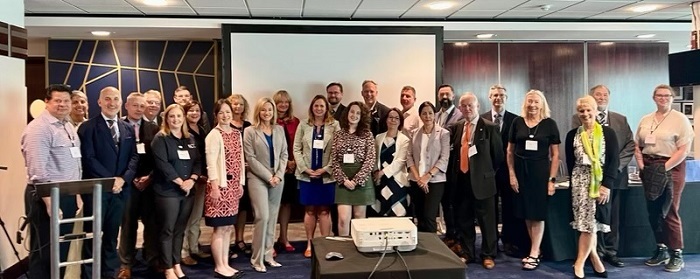 Participants in a workshop focused on stakeholder engagement gather for a photo. Representatives from EM, the United Kingdom’s Nuclear Decommissioning Authority and Canada’s Atomic Energy of Canada Limited took part in the event.
The trilateral group, which includes EM, the U.K.’s Nuclear Decommissioning Authority (NDA) and Canada’s Atomic Energy of Canada Limited (AECL), collaborates on the successful decommissioning and remediation of legacy nuclear sites and the safe management of their radioactive waste to ensure the protection of present and future generations and the environment in their respective countries.
“Engagement around how we deliver our decommissioning mission is vital and it’s been hugely valuable to host our international colleagues from U.S. and Canada as part of our trilateral agreement to discuss how we involve our stakeholders in our work,” said John McNamara, NDA head of stakeholder engagement. “It’s been an opportunity to share successes and utilize our collective knowledge and expertise to look at how we can overcome some common challenges. It’s also enabled all of us to get new ideas and inspiration so we can continue to improve how we engage and keep that conversation going.”
The workshop featured presentations, roundtables, case studies and opportunities for government agencies, local government, and interest groups to share successes and challenges related to stakeholder engagement.
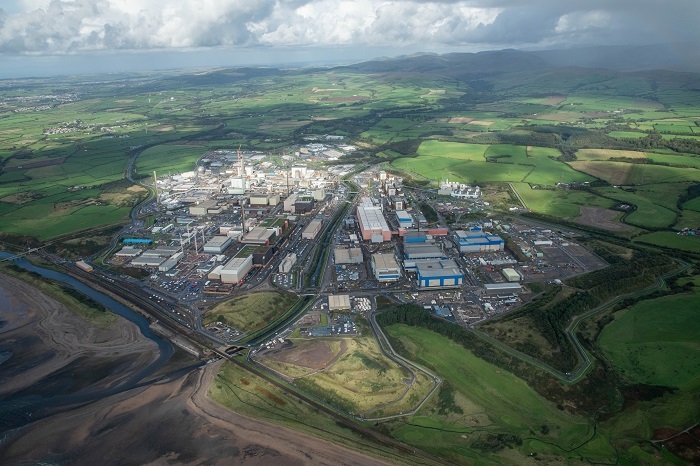 An aeriel view of the United Kingdom's Nuclear Decommissioning Authority Sellafield site.
NDA CEO David Peattie engaged with the participants in advance of their visit to NDA’s Sellafield site located on the coast of Cumbria, England. About 75 years ago, the Sellafield site helped create the U.K.’s nuclear deterrent and was home to the U.K.’s first commercial nuclear power station. The site houses around 85% of all the U.K.’s nuclear waste, on an area of less than 2 square miles. Today, NDA’s primary activities are nuclear waste processing and storage, and nuclear decommissioning.
As part of the ongoing trilateral collaboration, EM, NDA and AECL meet quarterly to discuss ongoing activities and identify potential areas of cooperation. Current areas of collaboration include in-situ decommissioning and disposal; stakeholder engagement; sustainability; workforce planning and project peer reviews; and aging infrastructure management. During standing committee meetings, subject-matter experts and managers from EM, NDA and AECL provide brief updates on these topics and discuss emerging areas for future collaboration.
“I know I will be going back to our cleanup program with a fresh perspective on stakeholder engagement,” said Ellis. “The dialogue at the workshop generated new ideas for ensuring we are reaching all our audiences. We want the public to not just be informed but involved in our cleanup mission, so our success is their success, too.”
 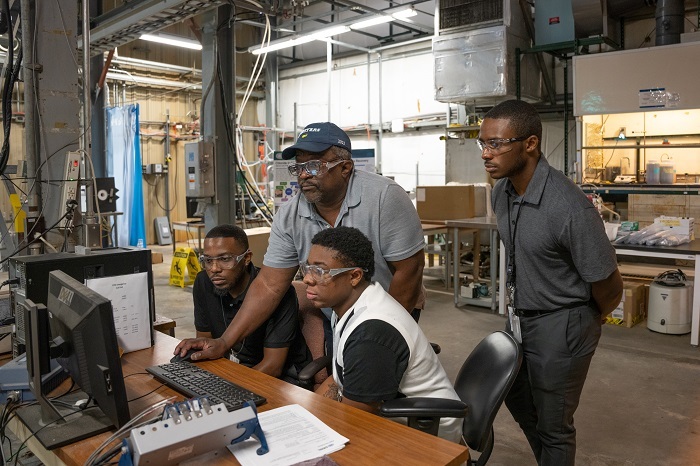 Savannah River National Laboratory (SRNL) employee Vernon Bush, center, and SRNL summer intern Jadrion Huell, standing at right, of Claflin University conduct a job shadowing activity with students Tredarius Lassiter, seated at left, and Tommy Applewhite. The group is monitoring a system in SRNL's Engineering Development Lab for a prototype melter system used to treat surrogate radioactive waste.
AIKEN, S.C. – A researcher named Inventor of the Year at Savannah River National Laboratory (SRNL) led a three-day event for EM’s Minority Serving Institutions Partnership Program (MSIPP) that included a collaborative workshop, job shadowing and a tour of the laboratory and Savannah River Site field activities.
The event led by Simona Hunyadi Murph drew nearly 90 participants, including students and professors from Tennessee, SRNL DOE Office of Science Visiting Faculty Program participants, and scientists and engineers from SRNL. Representatives from Fisk University, Tennessee State University, Meharry Medical College, University of South Carolina-Aiken, University of Puerto Rico-Mayagüez, Benedict College and University of Tennessee-Martin took part.
“Our innovative strategies to engage both students and faculty members from prestigious universities across the country in developing our future workforce for the execution of DOE-EM mission needs is a unique model for success that I and my colleagues are truly proud to be committed to,” said Murph. “As our program continues to thrive, we will expand our career-bridging initiatives to ensure we achieve our goals for success.”
 Spencer Gordon, a student from Tennessee State University, explores Savannah River National Laboratory’s flying probe machine in the process of reverse engineering while participating in the job shadowing and collaborative workshop event at the laboratory.
The collaborative workshop between scientists and professors was intended to inspire and initiate efforts to support EM missions and career exploration activities. Individualized job-shadowing opportunities matched students with SRNL mentors for a day, with the goal of increasing awareness of career opportunities throughout DOE.
Tennessee State University Professor Bharat Pokharel said the visit was memorable and very productive.
“We learned a lot and my students enjoyed visiting sites, shadowing with the scientists from SRNL and learning what SRNL offers for them. I personally had a great time and saw numerous opportunities to engage and collaborate with SRNL,” Pokharel said.
SRNL manages the EM-sponsored MSIPP, which promotes the education and development of the next generation workforce in critical science, engineering, technology, and math (STEM) related disciplines that compliment current and future EM missions.
“Engagement with minority serving institutions and historically black colleges and universities provides an opportunity to inform students about the real challenges of the EM mission and position a future workforce pipeline,” said SRNL EM MSIPP Program Manager Vivian Holloway. “Events like the SRNL and Tennessee job shadowing are critical to the success of this effort.”
Click here to learn more about the EM MSIPP.
-Contributor: Scott Shaw
  During a recent visit to the EM Los Alamos site, EM Principal Deputy Assistant Secretary Jeff Avery observed the excavation pit for corrugated metal pipe retrievals at Technical Area 54, Area G. From left: John Howard, EM deputy chief of staff; Ellie Gilbertson, deputy manager, EM Los Alamos Field Office; Avery; Aaron White, director, EM Office of Regulatory Compliance; and Brad Smith, president and general manager, Newport News Nuclear BWXT Los Alamos.
LOS ALAMOS, N.M. – Efforts to address legacy transuranic waste recently took an important step forward as the EM Los Alamos Field Office (EM-LA) and cleanup contractor Newport News Nuclear BWXT Los Alamos (N3B) have begun size reduction activities to prepare a portion of waste for permanent disposal.
EM-LA and N3B are preparing corrugated metal pipes containing transuranic waste at the Los Alamos National Laboratory (LANL) for shipment and disposal at EM’s Waste Isolation Pilot Plant (WIPP) in New Mexico. Crews recently began cutting the first retrieved pipes using hydraulic shears so that the pieces can be loaded into containers known as standard waste boxes for characterization, shipment and ultimate disposal.
“This is a significant milestone for N3B, and will help us continue to drive down legacy waste inventories at LANL and to aid the DOE Office of Environmental Management in its meeting commitments to New Mexico,” N3B President and General Manager Brad Smith said.
A significant amount of work and preparation went into ensuring N3B can perform this activity safely, Smith said.
“We’re grateful for the assistance of EM headquarters and EM-LA,” he said.
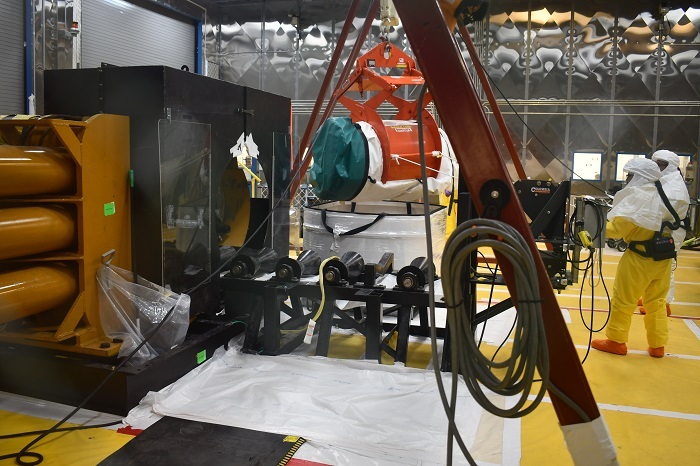 The Newport News Nuclear BWXT Los Alamos Waste Retrieval Operations crew at Technical Area 54 at Los Alamos National Laboratory guide a cut section of corrugated metal pipe filled with cemented transuranic waste into a standard waste box. Each pipe is loaded onto a pipe-roller conveyor belt before being cut into sections with a hydraulic shear, which is encased in a structure designed to prevent release of contamination to the outside environment.
The waste comes from a former LANL radioactive liquid waste treatment facility that operated during the Cold War era at Technical Area 21 (TA-21). In total, 158 pipes containing cemented waste were transported and buried at TA-54, Area G in 1986 for future retrieval.
Each pipe measures approximately 20 feet long, and weighs between 10,000 and 14,000 pounds. Given their size, the pipes must be reduced in size to be cut into five pieces, each of which is loaded into a standard waste box. N3B is working to complete the retrieval and processing of the pipes by next spring.
EM-LA and N3B conducted significant safety preparations prior to launching size reduction activities. Workers practiced processes and procedures using mock pipes before beginning cutting the actual ones.
The size reduction work takes place in Dome 375. The crew brings the pipes in one by one with a flatbed trailer onto a loading dock using a conveyer roller system. The pipe is attached to a winch, which then pulls it into position to be cut four times, resulting in five pieces approximately 4 feet long and up to 2,900 pounds.
According to N3B Waste Operator Robert Hansel, the shearing work is performed by a team of four people that includes an operator for the blade, the hoist, and the winch, and another lead person who is the reader performer. The reader performer controls the pace, sets the tone for the work and establishes a three-way communication approach that is central to reducing errors — reading the step, repeating the step and then confirming the step.
Previously, a diamond saw was envisioned to be used to perform the size reduction activities for the pipes. EM-LA and N3B shifted to the use of a hydraulic shear to improve safety and reduce potential worker exposure to dust. Prime Marine Services, Inc., an offshore decommissioning company in Broussard, Louisiana, created the initial design for the shear and N3B workers adapted it for use with the pipes. The shear operates similar to a cigar cutter to cut the pipes into pieces.
The pipes represent one of a variety of legacy waste streams at LANL that EM-LA and N3B are working collaboratively to address for disposal. To date, EM-LA and N3B have made over 152 shipments of transuranic waste to WIPP and shipped over 55,000 55-gallon drum equivalents of low-level and mixed low-level waste off-site.
-Contributors: Mike Nartker, Amanda Sanchez
  EM and Savannah River Mission Completion have published the latest edition of the Savannah River Site (SRS) Liquid Waste System Plan, which forecasts continued progress in achieving the liquid waste program processing goals at SRS.
AIKEN, S.C. – EM’s revised roadmap for completion of the liquid waste program at the Savannah River Site (SRS) is now available.
Developed by SRS liquid waste contractor Savannah River Mission Completion (SRMC) for EM, the Liquid Waste System Plan, Revision 23 documents the SRS liquid waste processing goals and operational outlook.
The system plan integrates and outlines the activities required for the disposition of existing and future high-level radioactive waste and the removal from service of radioactive liquid waste tanks and facilities belonging to the DOE-Savannah River Operations Office. It records a planning basis for waste processing in the liquid waste system through the end of the program mission.
Jim Folk, DOE-Savannah River assistant manager for waste disposition, said the system plan provides the strategy to finish the liquid waste mission while achieving milestone agreements and adhering to goals made between DOE and regulating agencies.
“DOE has worked collaboratively with Savannah River Mission Completion to plan for accelerated and aggressive performance in waste processing,” Folk said. “The updated SRS Liquid Waste System Plan outlines several production improvements that increase the feed and processing rates of our key facilities. Overall, we are forecasting the best possible outcome for dispositioning the remaining 34 million gallons of waste at SRS.”
The liquid waste program has seen substantial changes since the last system plan iteration, including:
- The Salt Waste Processing Facility (SWPF) began operation and has processed over 6 million gallons of dissolved salt solution;
- SRMC assumed operation of SWPF from the constructor of the facility;
- Construction of Saltstone Disposal Units 7 and 8 was completed;
- Three salt blend tanks are now in use to prepare feed for SWPF; and,
- The Defense Waste Processing Facility converted to an improved chemical flowsheet to increase processing capacity and reliability.
Also new to Revision 23 of the SRS plan is the incorporation of the newly developed liquid waste system modeling to identify process or facility improvements most likely to accelerate the liquid waste mission. The outputs from the computer models create tables, charts and schedules used for system planning and funding profiles for cleanup activities.
Partnering with technical subcontractor DBD, SRMC subject matter experts provide data input — such as tank capacities, operating limits, program priorities, processing steps, pump speeds, transfer routes, and planned and unplanned downtimes for facilities — to DBD to develop the model design basis and build the digital model. The SRMC experts validate the model against current physical plant performance. The model outputs are then analyzed using data visualization software to determine what process and facility changes are appropriate for implementation.
SRMC President and Program Manager Dave Olson said system modeling has played a key role in aligning the right factors to achieve the program’s No. 1 goal of reducing risk to the environment by removing waste and operationally closing tanks.
“Savannah River Mission Completion began our contract with the end in mind: to complete the liquid waste mission by 2037,” Olson said. “We will continue to put safety first, adhere to our core values and use the system plan to move forward with the treatment of the radioactive liquid waste in a manner that is responsible and meets the mission goals and objectives.”
-Contributor: Colleen Hart
 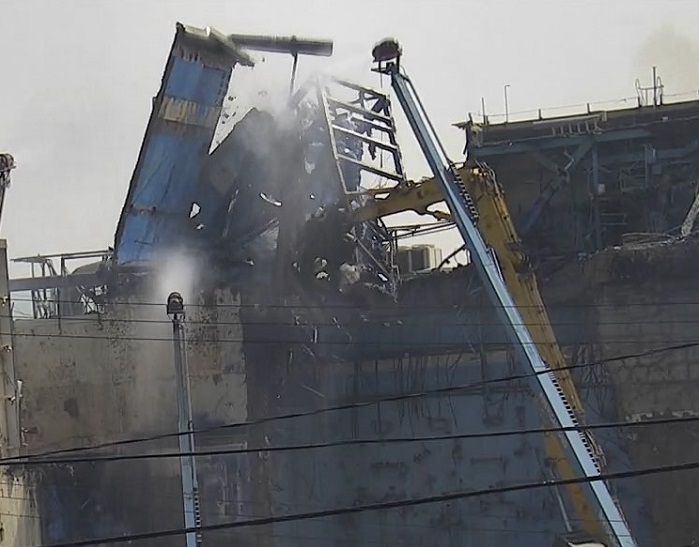 EM workers take down the Chemical Process Cell penthouse at the West Valley Demonstration Project. The enclosure housed a 125-ton shield door used during former nuclear fuel reprocessing operations. The controlled demolition began in September 2022.
WEST VALLEY, N.Y. – EM and its cleanup contractor at the West Valley Demonstration Project have safely removed a penthouse enclosure as part of ongoing demolition of the Main Plant Process Building.
“Safety comes down to planning, preparation and robust controls,” EM West Valley Main Plant Project Director Stephen Bousquet said. “Our team continues to perform work in a deliberate and methodical manner that’s protective of our workforce, the public and the environment.”
The Main Plant is one of the last remaining major facilities at West Valley. Its successful demolition will further reduce environmental risks and position the site for the next phase in cleanup. The demolition is expected to take approximately 30 months to complete.
Crews recently completed the controlled demolition of the Chemical Process Cell penthouse. A steel-framed and concrete block enclosure, it housed a 125-ton shield door used during former reprocessing operations. The enclosure also housed a mechanism to raise and lower the shield door.
The Chemical Process Cell was once used to dissolve sheared spent nuclear fuel and reduce the volume of high-level waste generated in the fuel reprocessing solvent extraction process.
Prior to removing the penthouse, crews with CH2M HILL BWXT West Valley (CHBWV) accessed the cell by dismantling its 5-foot-thick, steel-reinforced concrete walls. They took down the enclosure in a safe and deliberate manner while using equipment to control dust at its source. Workers also removed two levels of accessible steel storage racks and packaged debris for off-site disposal.
“Using lessons learned and a deliberate approach from previous demolition activities has been an excellent combination for safety and success,” CHBWV Facility Disposition Manager Tom Dogal said.
Crews are also working toward carrying out an EM 2023 priority: dispose of 9,000 tons of Main Plant demolition waste.
-Contributor: Joseph Pillittere
 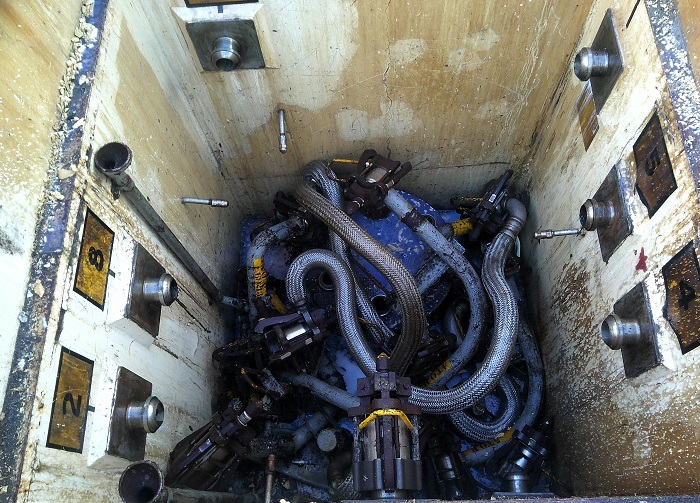 Workers with Washington River Protection Solutions dubbed this network of waste-tank connections “Medusa” because it looked like a head covered with snakes. It is pictured in November 2021 on the Hanford Site.
RICHLAND, Wash. – Hanford Site workers recently removed a complex piece of equipment that stood in the way of future tank-waste retrieval.
Dubbed “Medusa” after the Greek mythological creature with snakes for hair, the multi-hose connector was used for nearly 25 years to move liquid waste between waste-storage tanks before it went inactive in 1980.
In late 2021, crews with EM Office of River Protection (ORP) tank operations contractor Washington River Protection Solutions (WRPS) put a camera in one of the concrete pits at the A Tank Farm to prepare to retrieve waste and that’s when they discovered the Medusa and started plans to remove it.
“Removing equipment connected to the underground tanks to provide access to retrieve single-shell tanks is important work, given the waste stored inside,” said Jim Greene, the Tank Farms Program Division’s Single-Shell Tank Retrievals Program manager. “This removal work is an example of a cross-organizational collaboration to reduce radiological dose rates for the team and advance Hanford’s cleanup mission to protect the community and the environment.”
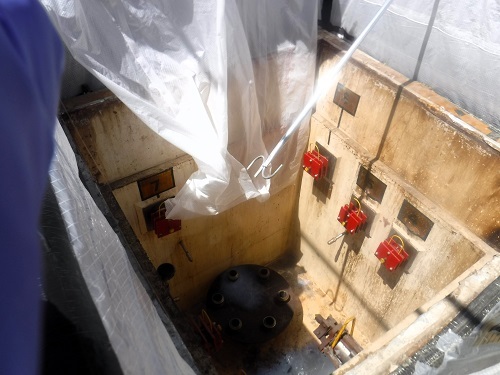
Workers used long-reach tools to clean out an enclosure above Tank A-102 so that pipefitters could remove the welding and break the equipment free. This is pictured in February 2022 on the Hanford Site.
|
In early 2022, workers used long-reach tools to remove and dispose of the hoses, clear out miscellaneous debris, and encapsulate contamination in the concrete Medusa pit at Tank A-102. However, the connector itself was welded in place and could not be removed with a long-reach tool.
The pit is only 6-by-6 feet wide and just shorter than 9 feet deep. It took crews months of planning to access the Medusa because long removal tools could not reach it. In June, it took two pipefitters individually working inside the tight enclosure, grinding the weld over the course of two days, to break the Medusa free.
“Working together as a team is essential for success on all jobs out here, especially when safety issues arise,” said Marco Nicacio, a pipefitter with subcontractor AEI Construction, who wore a double set of protective clothing, along with fire retardant clothing and a welder’s jacket and arm sleeves to do the work. “It’s a small, crowded pit, and we had to ensure the welding sparks and grinding dust were contained as best as possible. I felt comfortable, confident and safe while performing my tasks of the job.”
 It took two days for two pipefitters working inside the Tank A-102 enclosure on the Hanford Site to break some welded equipment free.
Crews used a crane to pull the connector from the pit, reducing the radiological exposure to workers by 90% from the original estimate.
“This was challenging, but it is a success story,” said Kalli Walton, the WRPS waste retrievals project manager overseeing the A Tank Farm operations. “We took our time and made sure we had the correct controls in place and everybody’s input was incorporated. At the end of the day, we got our pit cleared.”
The radioactive and chemical waste-storage tanks are in letter-designated underground fields called tank farms. Tank A-102 holds about 41,000 gallons of waste. Waste-retrieval activities are scheduled for summer 2025.
-Contributor: Kristin M. Kraemer

 Construction is underway on Area 5, the final permitted cell at Landfill V. This landfill is part of the Oak Ridge Reservation Landfills, which accept sanitary, industrial and construction waste generated from cleanup across the site.
OAK RIDGE, Tenn. – Oak Ridge Office of Environmental Management’s (OREM) lead cleanup contractor, UCOR, has started constructing the final permitted cell in Landfill V.
Landfill V is part of the Oak Ridge Reservation Landfills, which accept sanitary, industrial and construction waste generated from cleanup across the site.
With an expansion of five acres of land, Landfill V will provide almost half a million cubic yards of disposal space to support ongoing cleanup at the Y-12 National Security Complex and Oak Ridge National Laboratory. That equates to approximately 50,000 dump truck loads of added capacity.
“This landfill plays a vital role in supporting our ongoing operations, and this effort is helping extend our ability to use it for another 15 to 20 years,” says OREM Project Manager Dennis Mayton. “It provides nearby disposal services for our projects that are significantly more cost effective and lower risk compared to off-site disposal.”
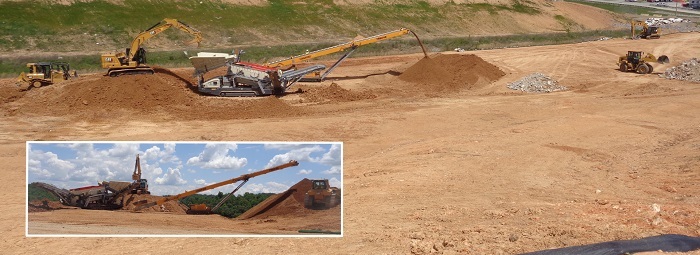 Large machinery, known as a soil screener, removes rocks to ensure the construction of the Landfill V expansion meets clay liner requirements. The Landfill V expansion project is on schedule to be completed by the end of the year.
The Oak Ridge Reservation Landfills have seen a 170% increase in waste receipts over the last five years. That rise is due in large part to the amount of soil being received from OREM remediation projects at East Tennessee Technology Park, which are all slated for completion next year.
The new landfill cell being constructed ensures on-site disposal availability. Expanding Landfill V’s disposal capacity also will extend the life of the Environmental Management Waste Management Facility (EMWMF), an important on-site disposal facility for low-level waste.
OREM disposes of sanitary, industrial and construction waste in Landfill V, while sending low-level contaminated waste to EMWMF. These complimentary efforts ensure space at EMWMF is used efficiently.
The expansion effort underway is being implemented under a UCOR-issued small business subcontract using a Tennessee Department of Environment and Conservation (TDEC)-approved design.
UCOR, TDEC and an independent quality assurance company are providing oversight, reviews and independent testing.
“This expansion is a critical step toward ensuring UCOR’s ability to support the current and future cleanup needs for years to come,” says UCOR Landfill Operations Project Manager Josh Pemberton. “A combined staff of 30 UCOR and CTI employees has proactively been planning and working to achieve this milestone for the past year and a half.”
CTI and Associates, Inc. is a small business supporting the effort.
The landfill expansion is on schedule to be completed by the end of the year.
OREM is also nearing the start of early site preparations for its Environmental Management Disposal Facility. That facility, which is slated to begin operations in the late 2020s, will provide an additional 2.2 million cubic yards of waste disposal capacity for low-level contaminated waste.
-Contributor: Kylie Julius-Schumacher
  A view of the Low-Activity Waste Facility at the Hanford Site. The National Academies of Sciences, Engineering and Medicine recently held a public meeting to discuss its third and final report that reviews the “Follow on Report of Analysis of Approaches to Supplemental Treatment of Low-Activity Waste at the Hanford Nuclear Reservation,” completed by the Federally Funded Research and Development Center, which is led by EM’s Savannah River National Laboratory.
The National Academies of Sciences, Engineering and Medicine (NASEM) recently held a public meeting to discuss its third and final report centered on EM’s tank waste cleanup mission at the Hanford Site in Washington state.
The academies are private, nonprofit institutions that provide expert advice on some of the most pressing challenges facing the nation and world. Their work helps shape sound policies, inform public opinion and advance the pursuit of science, engineering and medicine.
The NASEM report reviews the “Follow on Report of Analysis of Approaches to Supplemental Treatment of Low-Activity Waste at the Hanford Nuclear Reservation,” issued in January. That report was completed by the Federally Funded Research and Development Center (FFRDC), led by EM’s Savannah River National Laboratory (SRNL).
The NASEM report is the third providing a concurrent review of the analysis required by the 2021 National Defense Authorization Act for approaches to supplemental treatment of low-activity waste stored in large underground tanks at the Hanford Site.
“The final National Academies review report documents the committee findings and recommendations from its review of the final Federally Funded Research and Development Center’s report,” said Bill Bates, deputy associate laboratory director for environmental and legacy management at SRNL. “Throughout the multiyear process, the committee provided constructive input to the FFRDC that has been used to strengthen our final report.”
SRNL led the FFRDC team efforts, collaborating with researchers from DOE’s Los Alamos, Pacific Northwest and Sandia national laboratories, as well as the Consortium for Risk Evaluation with Stakeholder Participation, Institute for Defense Analyses, Parsons and TechSource to identify and analyze pathways for treating a portion of the low-activity waste at EM’s largest, most complex cleanup site: Hanford.
In its January report, the FFRDC team recommended multiple pathways for off-site grout solidification and disposal of low-activity waste be secured in parallel with the planned direct-feed low-activity waste vitrification process, which immobilizes the waste in glass.
The FFRDC team report says that, among other benefits, the recommended approach would provide the following:
- The capability to most rapidly reduce the amount of waste stored in Hanford’s underground single-shell and double-shell tanks;
- Additional long-term environmental protection, including two aquifers underlying the site and the Columbia River;
- Reduced potential for individual “choke points” to delay the Hanford tank-waste treatment and disposal mission; and
- Minimized financial demands and reduced mission duration and life-cycle costs.
The FFRDC report notes that only grout-based alternatives allow for the near-term disposition of low-activity waste that achieves the fastest reduction of risk of potential tank leaks. It also notes that grout-based alternatives are clearly executable at benchmark funding levels and have the highest probability of successful completion.
Vitrification, the FFRDC report said, has a lower probability of successful implementation for the supplemental treatment of low-activity waste because it is significantly more expensive than other technologies, such as grout.
The FFRDC report also says that fluidized bed steam reforming — which can convert radioactive liquid waste to a dry, granular mineral product — is a “first-of-a-kind technology” for Hanford and uncertainties in the process, performance and cost are higher than for grout or vitrification.
“The FFRDC team was extremely collaborative and worked well across all aspects of this effort,” said Bates. “We are hopeful that the report will help inform decision-makers and enable them to use the decision framework developed by the team.”
The FFRDC report developed and assessed some alternatives that would use off-site disposal to eliminate concern over additional potential effects on groundwater and the Columbia River from on-site disposal of non-vitrified low-activity waste, noting that about 70% of the inventory of contaminants could be removed from the Hanford Site in some alternatives.
Nearly 56 million gallons of radioactive and hazardous chemical waste remain to be treated at Hanford, and the FFRDC’s efforts provide a framework for decision-makers to develop part of the path toward expediting site closure while reducing risks and costs.
The NASEM report supports the use of that framework, while emphasizing the importance of the future regulatory and permitting processes, and stakeholder input.
-Contributor: Christopher O’Neil
|